Rolling Acne Scars
Acne is one of the most common skin conditions, affecting as many as 50 million Americans throughout their lifetimes, according to the American Academy of Dermatology. Unfortunately, the evidence of acne lesions can linger on the skin’s surface even after the initial breakout has cleared in the form of acne scars. Acne scars can take many forms, but the most common are atrophic acne scars, which appear like depressions dotted across the skin’s surface. These depressed scars form due to severe acne breakouts that do not heal properly; specifically, the body produces insufficient collagen, which results in indentation across the affected area. Rolling acne scars are one type of atrophic acne scar characterized by depressions with a sloping border, granting the skin a wavy, rolling texture. While rolling acne scars are permanent, meaning they will not fade on their own over time, the appearance of rolling acne scars can be reduced or eliminated with the help of combination cosmetic treatments available at Dr. Michele Green’s New York City dermatology practice.
For atrophic acne scar types, which include rolling acne scars, a combination approach is typically needed to fully heal and erase the scars, with a first step to address the depressions affecting the skin texture and a second step to address any discoloration or redness present as a result of scarring. At Dr. Green’s Upper East Side New York City dermatology office, a wide range of treatment options are available to eliminate all signs of rolling acne scars for patients of all skin types. To address the indentation visible on the top layer of skin, Dr. Green may turn to subcision paired with dermal fillers, punch excision, chemical peels, Fraxel fractional laser treatment, eMatrix non-ablative laser resurfacing, Microneedling, and microdermabrasion. In helping to eliminate hyperpigmentation and discoloration, Dr. Green may apply VBeam laser therapy or chemical peels, such as glycolic acid, salicylic acid, or trichloroacetic acid (TCA) peels. When so many options are available, it is best to consult an expert, board-certified dermatologist, such as Dr. Green.
Experienced, board-certified dermatologist, Dr. Michele Green, has been masterfully treating patients of all skin types with various medical and cosmetic concerns for over 25 years. Dr. Green knows that the most effective way to avoid acne scarring is to effectively treat acne or pimple breakouts early to prevent rolling acne scars from forming in the first place. With her many acne treatments and proprietary range of skincare products, MGSKINLABs, Dr. Green is well-equipped to treat acne and acne scars at any stage. Well-known for high patient satisfaction, Dr. Green has frequently been voted one of the best healthcare providers by such publications as Castle Connolly, Super Doctors, and New York Magazine.
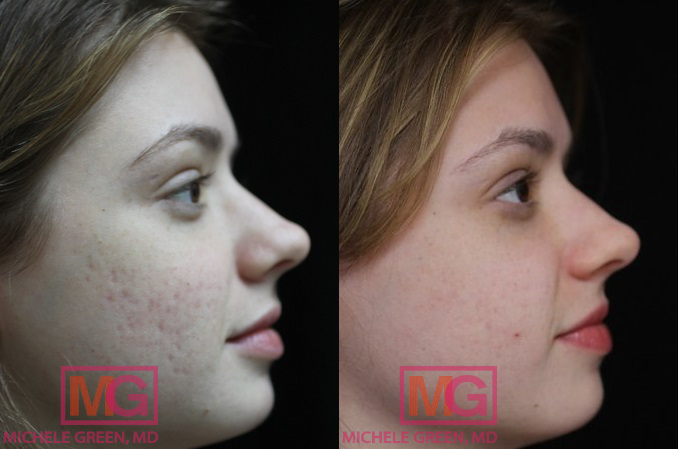
What are rolling acne scars?
Rolling acne scars are characterized by indentations that create a rolling or wavy look on the skin’s surface with sloping edges that measure a few millimeters wide. Caused by inflammatory acne that inhibits wound healing, rolling scars are produced when insufficient collagen production occurs following an acne breakout. Inflammatory acne occurs when the pores on the skin’s surface are clogged not only by sebum and dead skin cells but also by bacteria, which leads to infection under the skin. Depending on your body’s unique wound-healing process, this bacteria-infected acne, known as inflammatory acne or acne cysts, can lead to the formation of acne scars, and the deeper the infection, the more likely scarring will occur. Once scarring has occurred, the acne scars are permanent unless addressed by a cosmetic procedure.
What are the symptoms of rolling acne scars?
Rolling acne scars are a form of atrophic acne scars, meaning that depressions or indentations on the skin’s surface characterize them. They differ from other forms of atrophic acne scars – boxcar scars and icepick scars – in that the borders of the indentations are sloping rather than sharp or angular. Rolling acne scars give the skin’s surface a wavy appearance and develop most often where the skin is thicker, such as along the jawline or the lower face. They are formed due to tethering fibrous bands that connect the dermis, or outer layer of skin, to the subcutaneous tissue beneath, pulling on the epidermis and causing a rippling look to the skin. The size of rolling acne scars varies depending on how the acne lesion heals over time and frequently, the rolling acne scars can be larger in surface area than the acne lesion or cyst was initially.
What are the different types of acne scars?
Acne scars form from inflammatory acne, which damages the skin and prevents the lesions from healing properly. Two main types of acne scars can form atrophic acne scars and hypertrophic acne scars. Atrophic scars are characterized by depressions or indentations in the skin’s surface that are caused by insufficient amounts of new collagen produced during the healing process and can be further broken down into three main types: boxcar scars, icepick scars, and rolling scars. Boxcar scars form when inflammatory acne destroys the collagen fibers in the affected area, resulting in a lack of tissue support, which leads to depression in the skin. Typically oval or rounded in appearance, boxcar scars range in size and depth depending on how deep the infection was in the initial acne breakout. Boxcar scars are typically wider than icepick scars and have sharper edges than rolling scars. Icepick scars are named for the deep, narrow indent resulting from the severe inflammation of cystic or nodule acne that looks like the skin has been pierced with something thin and sharp like an icepick. The third main type of atrophic scar is the rolling scar, which results in a rolling or wavy appearance to the skin and is also caused by insufficient collagen production during the wound healing process.
Hypertrophic scars are raised scars that occur when an excess of collagen is produced during the natural healing process after inflection. Typically, when hypertrophic scars occur, the scar tissue grows larger in surface area than the initial lesion or injury. The main type of hypertrophic scar that occurs is the keloid scar, which is raised scar that appears thick and lumpy over the affected area. Some patients are more genetically predisposed to experiencing keloid scars, which a medical professional should only treat like Dr. Green.
Acne scars are also frequently characterized by post-inflammatory hyperpigmentation or discoloration of the skin that occurs after a severe acne breakout. Post-inflammatory hyperpigmentation is often treated separately with the VBeam laser to eliminate redness from the scar when treating atrophic or hypertrophic scars.
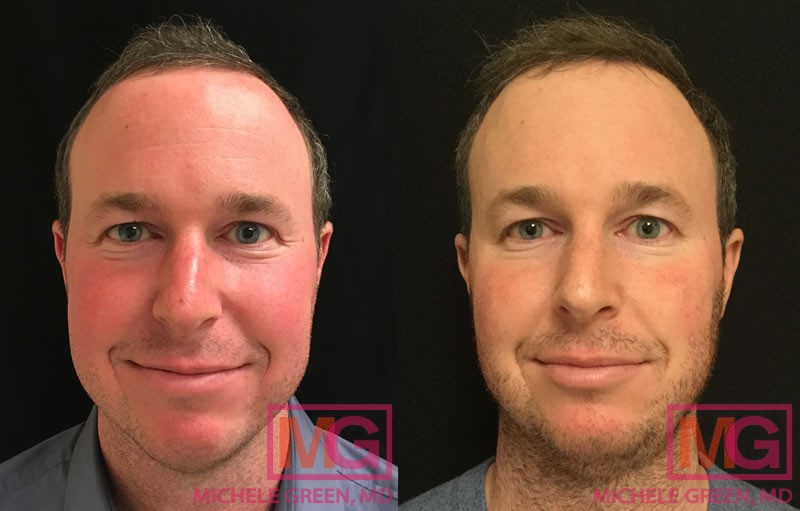
What type of acne causes rolling acne scars?
Acne is an extremely common skin condition that will affect up to 50 million Americans at some point. Of those 50 million, 40% will develop acne scars following an active breakout. Acne breakouts occur when the oil on the skin’s surface, known as sebum, and other debris, such as dead skin cells, clog the pores. In severe cases, bacteria will also get trapped in the pores resulting in inflammatory acne breakouts, nodular acne, pustules, and cysts. This inflammatory acne can damage the skin and inhibit the wound-healing process, leading to the appearance of acne scars. The deeper the infection, the more likely the lesions are to result in scarring. Picking or popping pimples can also increase the risk of developing acne scars, such as rolling scars, as popping pimples can lead to or spread infection or force debris deeper into the pores. Smoking can also be a risk factor for developing acne scars, such as rolling scars.
Can rolling acne scars go away on their own?
Most types of acne scars, once formed, are permanent. Rolling acne scars that form following an inflammatory acne breakout may fade a little over time but will not fully go away on their own. Luckily, many treatment options are available to eliminate the appearance of acne scars at a board-certified dermatologist’s office. With a wide range of cosmetic procedures that can treat rolling acne scars, the best first step when seeking treatment is to consult an expert, such as Dr. Green. When you have your initial consultation, Dr. Green will examine the treatment area to decide the combination treatment that will best meet your needs.
How to treat rolling acne scars
Rolling acne scars do not go away on their own; however, patients can eliminate the appearance of these atrophic scars with the help of cosmetic treatments available at Dr. Green’s dermatology office. When treating rolling acne scars, Dr. Green will typically recommend a combination approach to address the indentation in the surface of the skin and any post-inflammatory hyperpigmentation, or discoloration, that has occurred as a result of scarring. Many treatment modalities can be used, including Microneedling, chemical peels, laser treatment, chemical reconstruction of skin scars, dermabrasion, subcision and punch grafting. With so many options available, Dr. Green will begin the treatment session with a consultation to recommend the series of treatments that will be safest for your skin type and most effective at eliminating rolling scars.
What is Microneedling for rolling scars?
Microneedling, also known as collagen-induction therapy, is an effective treatment for improving skin tone and texture and reducing the appearance of rolling acne scar depressions. The non-invasive treatment works by applying tiny, surgical-grade needles that pierce the layers of the skin to create controlled micro-injuries, which trigger the body’s natural wound-healing response, increasing the production of the structural proteins collagen and elastin. When Microneedling is performed in an area with rolling acne scars, the new collagen production fills in the indentations on the skin’s surface, providing patients with smooth, even textured skin. Microneedling can also be paired with platelet-rich plasma (PRP) injections, further enhancing the treatment’s effects. To increase patient comfort, a topical numbing cream is applied before the treatment begins, and no downtime is required after.
Does derma rolling work for acne scars?
A derma roller is a handheld device that uses the same principle as Microneedling – the device has many tiny needles that pierce the skin’s surface to cause small, controlled micro-injuries, boosting collagen production in the treatment area to create smoother, clearer skin. Touted as a home remedy for acne scars and other skin irregularities, some derma rollers have been FDA-cleared to help improve skin color and texture. However, any device that can be used at home is not nearly as powerful as the treatments available at Dr. Green’s dermatology office. Making an appointment for Microneedling with Dr. Green gives patients much more noticeable results. Furthermore, patients using a derma roller at home should be cautious about using it correctly. Patients should avoid using derma rollers if they are experiencing an active herpes outbreak, have an autoimmune disorder or a weakened immune system, take blood thinners or prescription medication for acne, or suffer from bleeding disorders. The best way to get good treatment results is to visit an expert dermatologist, such as Dr. Green, rather than trying treatments at home.
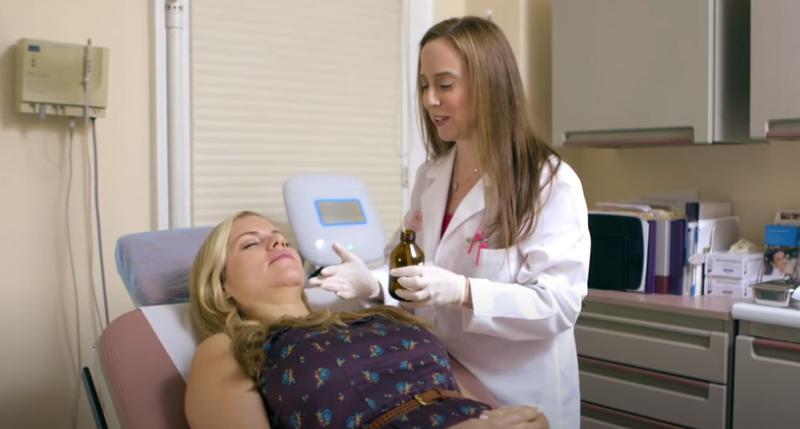
Do chemical peels work for rolling scars?
Chemical peels are an effective treatment for rolling scars designed to exfoliate the skin and promote skin cell turnover for a smoother, more even texture. There are many kinds of chemical peels composed of different exfoliating agents and different strengths: mild, medium, and deep. For rolling acne scars, Dr. Green recommends a mild or medium peel composed of one of the following exfoliating agents: glycolic acid, trichloroacetic acid, or salicylic acid. Glycolic acid chemical peels, which are mild, alpha-hydroxy acid peels, are often used for active acne breakouts as a way to clear the breakout and prevent the formation of acne scars in the first place. When applied to the skin, glycolic acid unclogs the pores of excess sebum, dead skin cells, and other debris, exfoliating the skin and reducing both current breakouts and the appearance of acne scars. A mild peel, glycolic acid is safe for lighter and darker skin types.
Dr. Green will also frequently employ the use of trichloroacetic acid (TCA) peel, which can range in depth and strength to combat acne scars and hyperpigmentation on the skin. One such application of the TCA peel is a TCA cross, which is a treatment in which the trichloroacetic acid is applied directly to the scar, leading to a “frosting” of the treatment area. Over the next few days, the skin will peel, leading to skin cell turnover. This promotes a more even texture and tone to the skin.
When choosing a chemical peel to treat your rolling acne scars, it is best to consult with a board-certified dermatologist, such as Dr. Green. When applied correctly and by an expert, only mild side effects are associated with the treatment, such as redness or dryness at the treatment site. But there is the possibility of more significant side effects, including hyperpigmentation, when applied improperly. As many options are available, Dr. Green helps patients determine which type of chemical peel will work best for them.
Can rolling acne scars be treated with laser?
Rolling acne scars can be treated with several forms of laser therapy, including the Fraxel laser, eMatrix laser, and VBeam laser. Each type of laser treatment uses a different form of energy to help erase the appearance of rolling acne scars on the skin’s surface, providing patients with clear, smooth, even-colored skin.
Fraxel laser resurfacing
The Fraxel laser is a non-ablative fractional laser that works to resurface areas of the skin precisely and is most effective for atrophic scars, such as rolling acne scars. When the Fraxel laser is applied to the treatment area, the beam of fractional light creates micro-injuries on the skin, which triggers the body’s natural production of collagen and elastin. When new collagen is produced, the depressions in the skin are filled in, resulting in smooth, even skin. To treat rolling acne scars, Dr. Green recommends scheduling between three and five sessions, each spaced a month apart, to achieve optimal results.
eMatrix laser for treating acne scars
The eMatrix laser uses radiofrequency technology to treat rolling acne scars and erase fine lines, wrinkles, stretch marks, and enlarged pores. FDA-approved, the eMatrix is a safe and effective non-ablative treatment that provides similar results to ablative laser treatments, however, while ablative laser treatments are associated with significant downtime and recovery time, eMatrix radiofrequency laser works to resurface the skin without the need for any recovery time. When applied to the treatment area, the eMatrix laser emits wavelengths of radiofrequency energy to trigger collagen production for smooth, even-textured skin. For results to be the most effective, Dr. Green recommends scheduling four to six eMatrix treatment sessions with results that will continue to improve in the three to six months post-treatment.
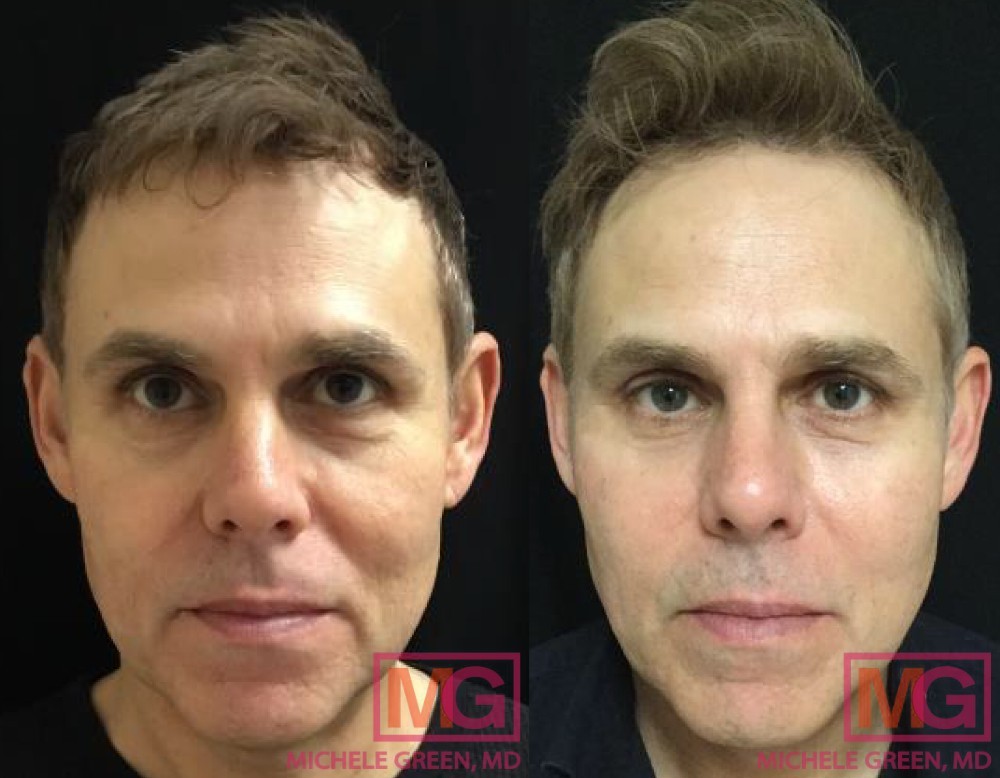
VBeam laser for rolling acne scar treatment
A common side effect of acne scarring is the post-inflammatory hyperpigmentation, or redness, that comes with scarring. When acne scars form, they often stay red or dark in color, and this discoloration can be targeted with the VBeam laser therapy. The VBeam pulsed light laser is the ideal laser treatment for any form of hyperpigmentation or redness, including acne scars, rosacea, varicose veins, stretch marks, and surgical scars. When applied to the treatment area, the VBeam laser emits pulses of light that are transformed into heat energy and absorbed by tissue with a red pigmentation, destroying the pigmentation while leaving the surrounding tissue unaffected. With patented cooling technology, no topical anesthetic is needed for high patient comfort, and no downtime is required after the treatment.
What is the subcision for rolling scars?
Subcision treatment is an ideal procedure for addressing rolling acne scars, in which the epidermal layer is tethered to the subcutaneous tissue, causing an indentation on the skin’s surface. Subcision works by inserting tiny needles under the skin where the scar is located. Once the needles are placed, Dr. Green uses the point to break the tethers that bind the bottom of the scar to the subcutaneous tissue, causing the tension to be released. Typically, Dr. Green pairs subcision with injections of hyaluronic acid dermal fillers, such as Restylane or Juvederm, or the poly-L-lactic acid filler, Sculptra, which is particularly effective for collagen induction. Dermal fillers help restore lost volume to depressions on the skin’s surface, while the subcision untether the fibrous bands that pull down on the epidermis.
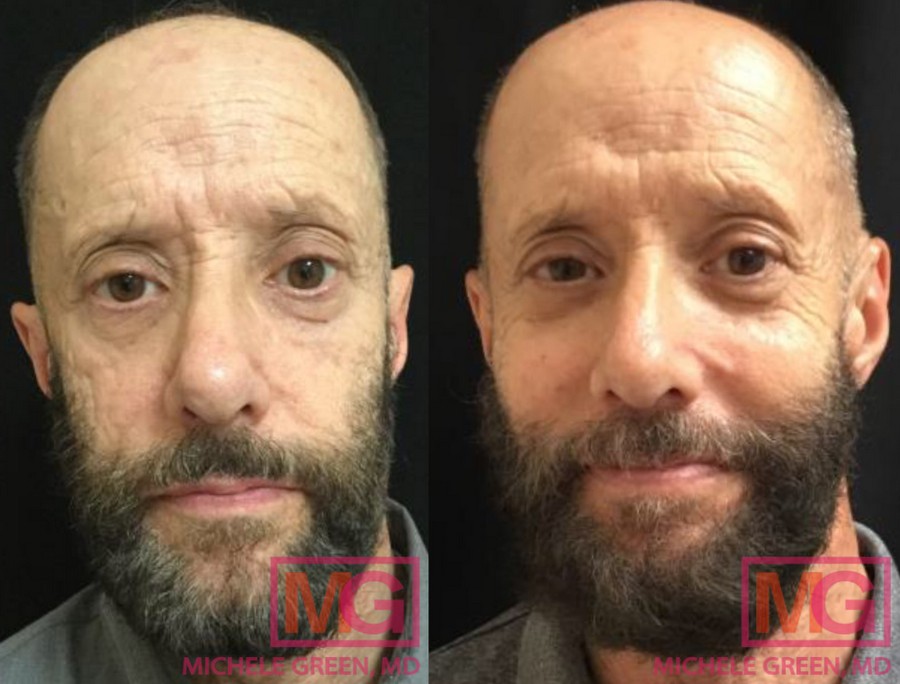
How can you tell if your acne scars are tethered?
Some forms of depressed acne scars are tethered, meaning that the bottom of the scar is attached with fibrous bands to the subcutaneous tissue below the surface of the skin, resulting in a depression on the surface of the skin. Rolling acne scars can often be tethered, in which case subcision treatment is often the best course of action as a way to break the fibrous bands causing the indentation on the skin’s surface. When you come in for your initial consultation with Dr. Green, she will examine the treatment area and be able to determine if the rolling acne scars are tethered and in need of subcision treatment.
What is the best treatment for rolling acne scars?
Rolling acne scars are difficult to treat and often require a combination approach to achieve the best results. The rolling scars are frequently characterized by depressions along the skin’s surface and redness or discoloration on the skin. To ameliorate the skin texture for smooth, even skin, Dr. Green will often recommend the Fraxel laser, eMatrix laser, chemical peels, or microneedling, or, if the scars are tethered, subcision paired with dermal fillers. Dr. Green may choose the V-Beam laser or chemical peels to address hyperpigmentation. No one treatment is necessarily “best,” rather it is important to choose the treatment or series of treatments that will be best for you depending on the width and depth of your scarring and skin type. Luckily, Dr. Green is an expert at treating patients of all skin types and finding the best treatment regime for each of her unique needs.
What is the worst thing about rolling acne scars?
Rolling acne scars can develop following severe inflammatory acne, leading to a rippling, wavy appearance to the skin. These scars are permanent, meaning they will not go away on their own, and can make patients feel self-conscious long after the initial acne breakout has faded. Luckily, there are many treatment options available at Dr. Green’s New York City dermatology office so that you no longer have to live with uneven, discolored skin. Make your initial consultation appointment with Dr. Green to see which treatments will best meet your needs.
What is the best procedure for rolling acne scars?
When it comes to treating rolling acne scars, there are many treatment options available at Dr. Green’s dermatology office. Microneedling collagen induction treatment can help to boost collagen production for smoother, brighter skin. At the same time, chemical peels work to exfoliate the skin, promote skin cell turnover, and clear active acne breakouts. There is a range of laser therapy options, including Fraxel lasers and eMatrix lasers for skin resurfacing and the V-Beam laser for addressing post-inflammatory hyperpigmentation, all of which require no downtime following treatment. When acne scars are tethered, subcision paired with dermal fillers are effective treatments to break the fibrous bands causing the depression in the skin and simultaneously fill in lost volume. To determine which treatment options are best for you, schedule your initial consultation with Dr. Green by calling the NYC office.
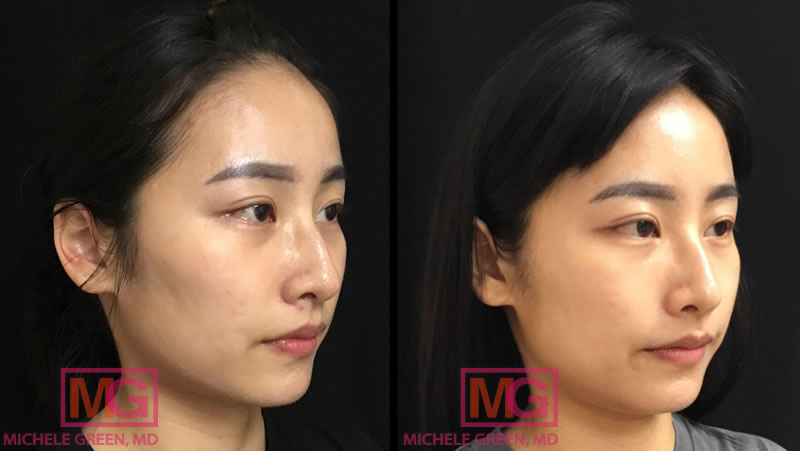
YJL ematrix acne scars 2wk ba ANGLER MGwatermark
How do I get started with the treatment of acne scars today?
Acne is an incredibly common skin condition that can often result in various scar types. Acne scars can be an even more challenging concern to treat than the breakouts themselves and, for many, may cause feelings of self-consciousness or low self-esteem. Luckily, board-certified dermatologist Dr. Michele Green offers a host of non-invasive treatment options for reducing the appearance of acne scars and achieving clear, smooth, healthy skin that lasts. Depending on your skin type and the types of acne scars present, the treatment options recommended by Dr. Green may include microneedling, chemical peels, subcision with dermal fillers, and laser treatments, among others.
Dr. Michele Green in New York City is an internationally renowned board-certified dermatologist with over two and a half decades of experience providing the best non-invasive treatment options available, including for the medical treatment of acne and cosmetic treatment of acne scars. Castle Connolly, Super Doctors, New York Magazine, and the New York Times consistently identify Dr. Green as one of NYC’s best dermatologists for her dedication to patients and expertise. Dr. Green takes a holistic approach to skin rejuvenation, customizing the treatment plans of each patient to cater best to their specific needs and overall aesthetic goals. When you consult with Dr. Green at her private dermatology office in Manhattan’s Upper East Side, she will work with you to develop a personalized treatment plan that incorporates a combination of cosmetic treatment options and specially formulated skincare products best suited to your skin condition and goals so that you look and feel like the very best version of yourself. To schedule a consultation with Dr. Green and get started with your treatment plan for healthy, radiant, beautiful skin that lasts, call the NYC-based office at 212-535-3088 or contact us online today.
 212-535-3088
212-535-3088